第四节《电流的强弱》教案(人教版初二上)
- 格式:doc
- 大小:288.50 KB
- 文档页数:4
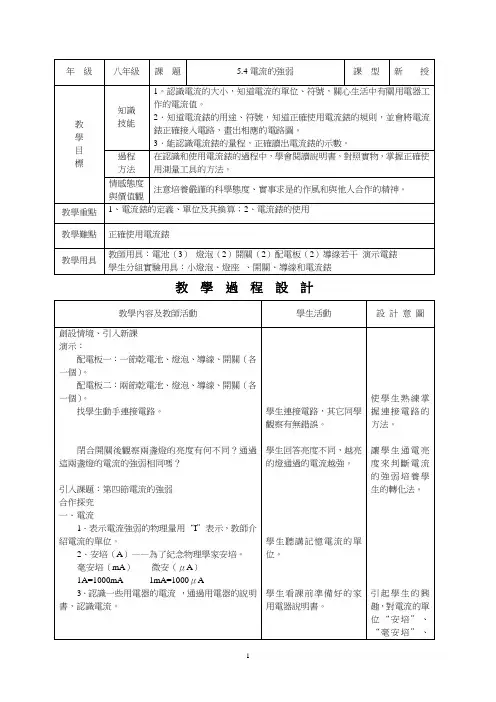
教學過程設計教師點評讀數方法。
課堂小結:學生總結電流的單位和電流錶的使用方法。
②分析分度值;③看偏過了多少格。
讓學生對知識進行回顧,概括加深對知識的印象。
課堂練習課內練習:動手動腦學物理。
課外作業:1.2.6×10-2A= mA= μA;35 mA= A.2.請讀出下圖電流錶的示數。
3.下列電流值中,最小的是()A.0.4A B.0.5×105μAC.480mAD.9.6×10-4A4.如圖所示電路中,電流錶測量的是A.通過燈L1的電流B.通過燈L2的電流C.通過燈L1和L2的電流D.電源供給電路的總電流5.如圖所示,M、N表示一個電流錶的兩上接線柱,a、b、c、d表示電路中的四個連接點,若想用此電流錶測量小燈泡的電流,則以下連接正確的是()。
A.M接a,N接bB.M接d,N接aC.M接c,N接dD.M接d,N接c6.小明測量得到家裡只有一種用電器工作時,電路中的電流為5A,該用電器可能是()A.電視機B.半導體收音機C.微波爐D.日光燈7.有0~0.6A和0~3A兩個量程的電流錶,實驗中需用0~0.6A這一量程,但這一量程的刻度值不夠清楚,某一次測量中,從0~3A量程的刻度盤上發現指標正好指在2.3A的刻度線上,則測得的實際電流大小為()A.0.43A B.046AC.0.7A D.2.3A8、如圖所示,是實驗室中常用的一種儀錶的示意圖。
請寫出你從圖中得到的兩條資訊:①________________;②________________。
9.在方框中畫出燈泡L1和燈泡L2並聯、電流錶測燈泡L1電流的電路圖,並在圖上連接實物圖。
板書設計5.4 電流的強弱單位:安培(A)、毫安培(mA)、微安(μA)構造電流串連接“+”進“-”出電流錶的使用量程的選擇量程讀數分度值多少格教學反思。
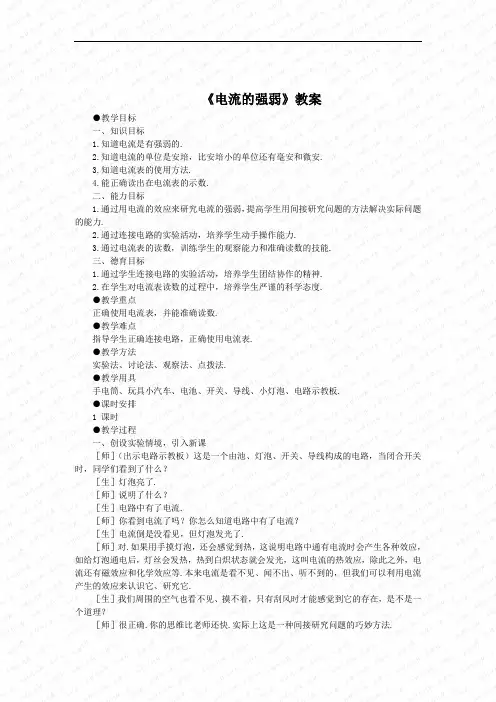
《电流的强弱》教案●教学目标一、知识目标1.知道电流是有强弱的.2.知道电流的单位是安培,比安培小的单位还有毫安和微安.3.知道电流表的使用方法.4.能正确读出在电流表的示数.二、能力目标1.通过用电流的效应来研究电流的强弱,提高学生用间接研究问题的方法解决实际问题的能力.2.通过连接电路的实验活动,培养学生动手操作能力.3.通过电流表的读数,训练学生的观察能力和准确读数的技能.三、德育目标1.通过学生连接电路的实验活动,培养学生团结协作的精神.2.在学生对电流表读数的过程中,培养学生严谨的科学态度.●教学重点正确使用电流表,并能准确读数.●教学难点指导学生正确连接电路,正确使用电流表.●教学方法实验法、讨论法、观察法、点拨法.●教学用具手电筒、玩具小汽车、电池、开关、导线、小灯泡、电路示教板.●课时安排1●教学过程一、创设实验情境,引入新课[师](出示电路示教板)这是一个由池、灯泡、开关、导线构成的电路,当闭合开关时,同学们看到了什么?[生]灯泡亮了.[师]说明了什么?[生]电路中有了电流.[师]你看到电流了吗?你怎么知道电路中有了电流?[生]电流倒是没看见,但灯泡发光了.[师]对.如果用手摸灯泡,还会感觉到热,这说明电路中通有电流时会产生各种效应,如给灯泡通电后,灯丝会发热,热到白炽状态就会发光,这叫电流的热效应,除此之外,电流还有磁效应和化学效应等.本来电流是看不见、闻不出、听不到的,但我们可以利用电流产生的效应来认识它、研究它.[生]我们周围的空气也看不见、摸不着,只有刮风时才能感觉到它的存在,是不是一个道理?[师]很正确.你的思维比老师还快.实际上这是一种间接研究问题的巧妙方法.二、新课教学[师]请大家仔细观察桌上的小灯泡,看灯泡上标有什么?[生]有数字和符号.[师]灯泡上一部分是它的电流值.I是电流这个物理量的符号.0.2 A是同学们实验时用的小灯泡的正常工作时的电流值.电流I的单位是安培,简称安,符号是A.下面我要问大家了,0.2 A表示什么意思?[生]小灯泡正常工作时的电流是0.2安培.[师]大家还有什么问题吗?[生]安培是怎么来的?[师]安培是法国的科学家,他在物理、化学、数学等方面都有很深的造诣,安培在电学方面的研究成果尤为突出,被后人称为“电学中的牛顿”.为了纪念他,物理学中用安培作为电流的单位.希望同学们能向安培学习,刻苦钻研,勇于开拓和创新.[生]电流还有其他单位吗?[师]请大家快速阅读课本中另外两个电流的单位,并完成下列问题:[投影]1.电流的单位还有_______和_________,符号分别是_______和__________.2.电流单位的换算关系是:1 A=________ mA1 mA=_______ μA3.把《小数据》中计算器中电源的电流值、半导体收音机电源的电流值.手电筒中的电流值分别换算为以安培为单位的电流值.[师]同学们阅读了一些电器的电流值,为什么都不一样呢?[生]说明电流有强有弱.[师]大家看我手里有手电筒和一只玩具小汽车,当它们的灯发光时,你能判断谁的电流强,谁的电流弱?再换一辆不同的汽车呢?[生]灯泡发光越亮,电流越强.[实验]怎样连接电流表.[师]现在请同学们用你桌上的灯泡、导线、电池组成电路,先用一节电池供电,再用两节电池供电,注意观察灯泡的亮度.[生]用两节电池供电时灯泡亮一些,说明电流大.[师]现在每组发一个能直接测出电流值的电表——电流表.在刚才的电路中,再接入电流表,就可以测出灯泡的电流值.不过,大家要先阅读课本,讨论一下,要注意什么原则才算正确连接电流表.讨论之后,总结出以下几条规则:规则1:电流表必须和被测的用电器串联;规则2:电流必须从“+”接线柱流进去;“-”接线柱流出来;规则3:不要超过电流表的量程.学生用电流表有两种量程,电流值小时用标着“0.6”的接线柱和“-”接线柱;电流值小于0.6 A时用标着“3”接线柱和“-”接线柱.规则4:任何情况下都不能使电流表直接连到电源的两极上.[师]掌握电流表的连接后,两人一组开始把你的电流表接入电路中,要注意规则.(学生实验,教师给予帮助和指导)[阅读课本]怎样在电流表上读数读数时,要看清两点:看清所选量程的每一大格、每一小格各表示的电流值;看清测量时表针停在哪个大格、哪个小格上.学生读数后,教师让几个小组把测得的灯泡电流值报上来,讨论出现的问题:[生甲]我们组测得的值与灯泡上标的正常值不太相符,我们讨论后认为是导线上消耗了一部分电能,所以电源的电能输送给灯泡时达不到灯泡需要的正常电流值,灯泡也就不如正常时的亮.[生乙]我们组连接电路都正确,但读数时看到另外的量程刻度上了,所以和别的组不一样.经过认真检查后,改正了错误.[生丙]我觉得连接电路时关键要注意电流表“+”接线柱是“0.6 A”接线柱还是“3 A”接线柱,确定之后就好办了.[生丁]我有一个问题,这个实验中的小灯泡上标有“0.2 A”于是我们选“0.3”接线柱,如果灯泡上不标电流值呢?[师]经过两节的电路学习,同学们对电路不再陌生.实验时很认真,实验后又能很好地总结 .现在,又提出了问题,我非常高兴!这个问题可以用试触法解决,你把两根导线和电流表的两个接线柱只要一接触(不要固定),就可看出电流表的表针是否超过你估计的量程.如表针正好在你估计的量程内,你只要把导线固定好读数即可,相反,不在你估计的量程内呢?[生]换成另一量程的两个接线柱即可.[师]对.这种试触法在以后的电学中还会用到,如用电压表测电压值等.三、小结本节课我们主要学习了以下内容:1.可以用电流来表示电流的强弱.2.正确连接电流表:电流表与被测用电器要串联;电流要从电流表的“+”接线柱进,“-”接线柱出;不要超过电流表的量程;不要把电流表直接连到电源的两极上.3.正确读出电流表的读数.四、布置作业P100动手动脑学物理1、2、3写在作业本上.[动手动脑学物理参考答案]1.此题是考查单位换算的练习,只要掌握安培和毫安之间的换算关系1 A=1000 mA,就可很快得出结果:0.25 A=250毫安(mA)120 mA=0.12 A2.本题分三步:第一先让学生画出电路图,注意电流表要串联在电路中,并保持电流从表的“+”接线柱流入,从“-”接线柱流出,如下图所示.第二步:让学生动手连接实物图,以加强从“电路图”到“实物连接”之间的操作训练.第三步:通过电流表读出电路值,训练学生正确读出电流表的数值.3.电流表甲的读数是0.32 A电流表的乙的读数是0.56 A电流表丙的读数是1.4 A学生读完之后,互相检查,有部分学生不够认真,读小格数时出现错误;部分学生没看清接线柱接入电路中是哪个量程,就读出了读数,这个问题在练习中都应让学生注意.五、板书设计电流的强弱。
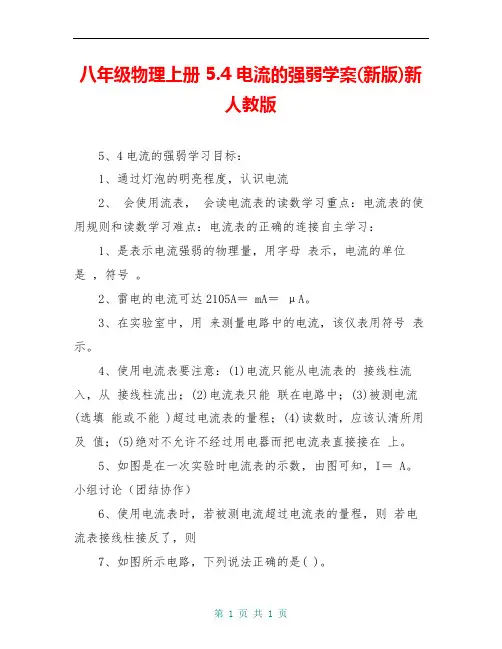
八年级物理上册 5.4 电流的强弱学案(新版)新人教版5、4电流的强弱学习目标:1、通过灯泡的明亮程度,认识电流2、会使用流表,会读电流表的读数学习重点:电流表的使用规则和读数学习难点:电流表的正确的连接自主学习:1、是表示电流强弱的物理量,用字母表示,电流的单位是,符号。
2、雷电的电流可达2105A= mA=μA。
3、在实验室中,用来测量电路中的电流,该仪表用符号表示。
4、使用电流表要注意:(1)电流只能从电流表的接线柱流入,从接线柱流出;(2)电流表只能联在电路中;(3)被测电流(选填能或不能 )超过电流表的量程;(4)读数时,应该认清所用及值;(5)绝对不允许不经过用电器而把电流表直接接在上。
5、如图是在一次实验时电流表的示数,由图可知,I= A。
小组讨论(团结协作)6、使用电流表时,若被测电流超过电流表的量程,则若电流表接线柱接反了,则7、如图所示电路,下列说法正确的是( )。
A、L1、L2串联B、开关S只控制L2C、电流表测干路中电流D、电流表测L1的电流四、精讲释疑8、如下图所示,将所给的元件连接起来,要求L1、L2并联,电流表测干路电流,开关控制整个电路,根据实物连接图画电路图。
本节内容,你还有何疑问?小结:1、电流表示电流的强弱。
单位是符号是()、还有毫安(mA)、微安(μA);1A= mA,1mA= μA。
2、电流表有两个量程:分别是(每小格 A)(每小格 A)使用:(1)、电流表要联在被测电路中;(2)、接线柱的接法要正确,电流从“ ”接线柱流入,从“ ”接线柱流出。
(3)、被测电流超过电流表的量程;不确定时用大量程。
(4)、允许不经过用电器把电流表直接接到电源两极上。
3、一台家用小型(47厘米)彩色电视机正常工作时,通过它的电流强度与下列哪一组数据最接近()A、18AB、1、8AC、180 mAD、18 mA4、如下图所示,甲电流表的读数是 A,乙电流表的读数是A5(选做)、请你设计一个电路图,要求将L1、L2并联,开关S1作总开关,S2控制灯L2,电流表测A1测干路电流,电流表A2测L1所在支路电流,请按要求将下图中所画的实物连接好,并根据实物图画出电路图。
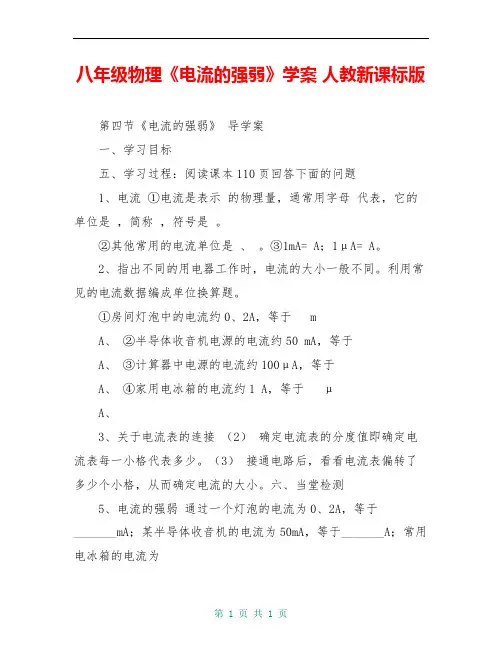
八年级物理《电流的强弱》学案人教新课标版第四节《电流的强弱》导学案一、学习目标五、学习过程:阅读课本110页回答下面的问题1、电流①电流是表示的物理量,通常用字母代表,它的单位是,简称,符号是。
②其他常用的电流单位是、。
③1mA= A;1μA= A。
2、指出不同的用电器工作时,电流的大小一般不同。
利用常见的电流数据编成单位换算题。
①房间灯泡中的电流约0、2A,等于mA、②半导体收音机电源的电流约50 mA,等于A、③计算器中电源的电流约100μA,等于A、④家用电冰箱的电流约1 A,等于μA、3、关于电流表的连接(2)确定电流表的分度值即确定电流表每一小格代表多少。
(3)接通电路后,看看电流表偏转了多少个小格,从而确定电流的大小。
六、当堂检测5、电流的强弱通过一个灯泡的电流为0、2A,等于_______mA;某半导体收音机的电流为50mA,等于_______A;常用电冰箱的电流为1、2A,等于__________μA。
小明的计算器工作时的电流为80μA,等于________A。
6 、电流表的连接(1)一是电流必须从___接线柱(或“___”号接线柱)流进,从___色接线柱(或“___”号接线柱)流出来。
二是正确使用两个量程,不能过大或过小。
三是电流表必须和被测的用电器___联。
任何情况下都______ 使电流表直接连到电源的两极上。
(2)某电路中的电流大约为0、4A,一同学要准确测量这个电路中的电流值,他选用的电流表有两个量程:0-0、6A及0-3A,他是用0-3A的量程来测量,他这样的结果是:( )A、测不出电流值B、电流表的指针可能被打弯C、电流表可能被烧坏D、测量的精确程度差一些7、电流表的读数:上图所示是电流表表盘的示意图,左图,它选用的量程是________,每一小格表示______A,此时电流表的读数是_______A;如右图,它选用的量程是_________ ,每一小格表示______A,此时电流表的读数是_______A。
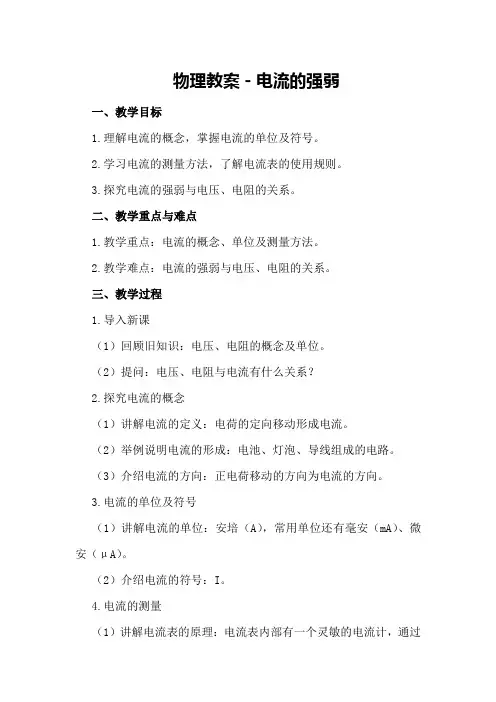
物理教案-电流的强弱一、教学目标1.理解电流的概念,掌握电流的单位及符号。
2.学习电流的测量方法,了解电流表的使用规则。
3.探究电流的强弱与电压、电阻的关系。
二、教学重点与难点1.教学重点:电流的概念、单位及测量方法。
2.教学难点:电流的强弱与电压、电阻的关系。
三、教学过程1.导入新课(1)回顾旧知识:电压、电阻的概念及单位。
(2)提问:电压、电阻与电流有什么关系?2.探究电流的概念(1)讲解电流的定义:电荷的定向移动形成电流。
(2)举例说明电流的形成:电池、灯泡、导线组成的电路。
(3)介绍电流的方向:正电荷移动的方向为电流的方向。
3.电流的单位及符号(1)讲解电流的单位:安培(A),常用单位还有毫安(mA)、微安(μA)。
(2)介绍电流的符号:I。
4.电流的测量(1)讲解电流表的原理:电流表内部有一个灵敏的电流计,通过测量电流计的偏转角度来确定电流的大小。
(2)演示电流表的使用方法:将电流表串联在电路中,红表笔接电源正极,黑表笔接电源负极。
(3)注意事项:电流表不允许直接接在电源两端,以免损坏电流表。
5.电流的强弱与电压、电阻的关系(1)提出问题:电流的强弱与哪些因素有关?(2)引导学生进行实验:改变电压、电阻,观察电流的变化。
6.课堂小结(1)回顾本节课所学内容:电流的概念、单位、测量方法及电流与电压、电阻的关系。
(2)布置作业:设计一个电路,测量不同电压、电阻下的电流。
四、课后作业1.请列举生活中常见的电流单位,并解释其含义。
2.请简述电流表的使用方法及注意事项。
3.设计一个实验,验证电流与电压、电阻的关系。
五、教学反思本节课通过讲解电流的概念、单位、测量方法及电流与电压、电阻的关系,使学生掌握了电流的基础知识。
在教学过程中,注重引导学生进行实验,培养学生的动手能力和观察能力。
但部分学生在电流表的使用方法上还存在疑惑,需要在课后加强辅导。
总体来说,本节课达到了预期的教学目标。
重难点补充:1.教学重点:电流的概念、单位及测量方法对话设计:教师问:“同学们,你们知道电流是什么吗?能举个例子吗?”学生甲回答:“电流就是电子流动,就像河水一样。
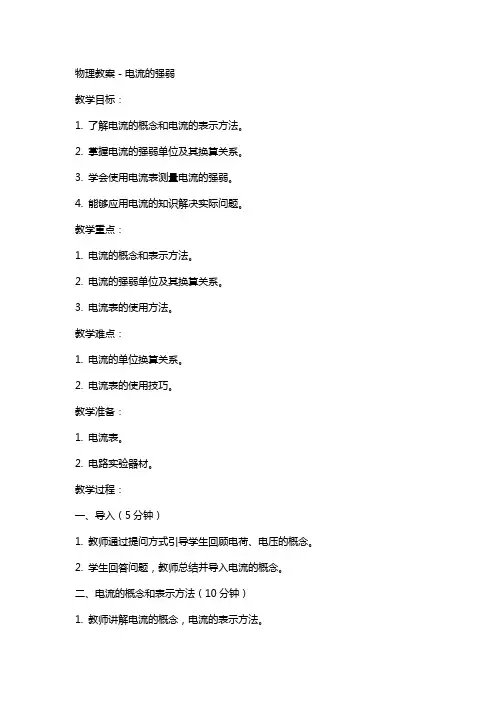
物理教案-电流的强弱教学目标:1. 了解电流的概念和电流的表示方法。
2. 掌握电流的强弱单位及其换算关系。
3. 学会使用电流表测量电流的强弱。
4. 能够应用电流的知识解决实际问题。
教学重点:1. 电流的概念和表示方法。
2. 电流的强弱单位及其换算关系。
3. 电流表的使用方法。
教学难点:1. 电流的单位换算关系。
2. 电流表的使用技巧。
教学准备:1. 电流表。
2. 电路实验器材。
教学过程:一、导入(5分钟)1. 教师通过提问方式引导学生回顾电荷、电压的概念。
2. 学生回答问题,教师总结并导入电流的概念。
二、电流的概念和表示方法(10分钟)1. 教师讲解电流的概念,电流的表示方法。
2. 学生跟随教师一起总结电流的表示方法:用字母I表示,单位是安培(A)。
三、电流的强弱单位及其换算关系(10分钟)1. 教师讲解电流的强弱单位:毫安(mA)和微安(μA),并介绍换算关系。
2. 学生跟随教师一起总结电流单位换算关系:1A=1000mA,1A=1,000,000μA。
四、电流表的使用方法(10分钟)1. 教师讲解电流表的使用方法,包括接线方式、测量范围、读数方法等。
2. 学生在教师的指导下,进行电流表的使用操作练习。
五、课堂小结(5分钟)1. 教师引导学生总结本节课所学内容:电流的概念、表示方法、单位换算关系和电流表的使用方法。
2. 学生回答问题,教师点评并总结。
教学反思:本节课通过提问方式引导学生回顾电荷、电压的概念,引出电流的概念。
在讲解电流的表示方法、单位换算关系和电流表的使用方法时,注意与学生的互动,让学生积极参与,提高课堂效果。
在电流表的使用操作练习中,教师要耐心指导,确保学生掌握正确使用电流表的方法。
六、电流的计算(10分钟)1. 教师讲解电流的计算方法,电流的计算公式:I = Q/t,其中I表示电流,Q 表示电荷量,t表示时间。
2. 学生跟随教师一起总结电流的计算公式,并进行例题讲解。
七、电流的磁场效应(10分钟)1. 教师讲解电流的磁场效应,介绍安培定则。
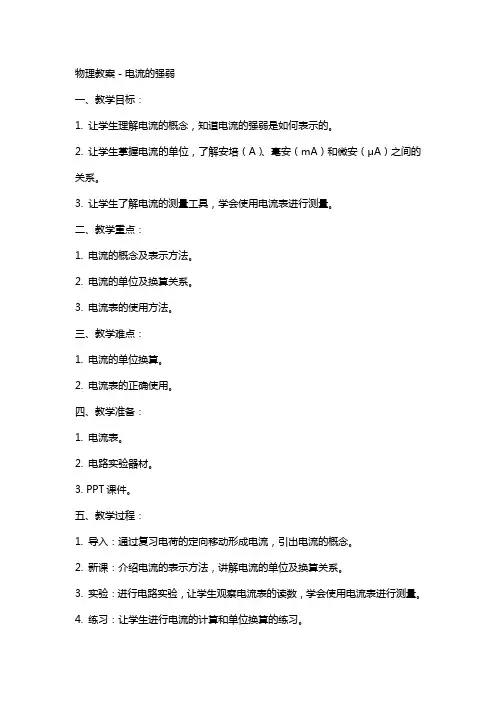
物理教案-电流的强弱一、教学目标:1. 让学生理解电流的概念,知道电流的强弱是如何表示的。
2. 让学生掌握电流的单位,了解安培(A)、毫安(mA)和微安(μA)之间的关系。
3. 让学生了解电流的测量工具,学会使用电流表进行测量。
二、教学重点:1. 电流的概念及表示方法。
2. 电流的单位及换算关系。
3. 电流表的使用方法。
三、教学难点:1. 电流的单位换算。
2. 电流表的正确使用。
四、教学准备:1. 电流表。
2. 电路实验器材。
3. PPT课件。
五、教学过程:1. 导入:通过复习电荷的定向移动形成电流,引出电流的概念。
2. 新课:介绍电流的表示方法,讲解电流的单位及换算关系。
3. 实验:进行电路实验,让学生观察电流表的读数,学会使用电流表进行测量。
4. 练习:让学生进行电流的计算和单位换算的练习。
6. 作业:布置相关作业,巩固所学知识。
教学反思:在授课过程中,要注意让学生充分理解电流的概念,掌握电流的表示方法。
要注重实验操作的指导,确保学生能够正确使用电流表。
在教学过程中,要关注学生的学习情况,及时解答学生的疑问,提高教学效果。
六、教学拓展:1. 介绍电流的种类,包括直流电和交流电。
2. 讲解直流电和交流电的特点和应用。
3. 引导学生思考电流在实际生活中的作用。
七、课堂小结:1. 回顾本节课所学内容,让学生强化对电流概念、单位及测量方法的理解。
2. 强调电流在日常生活和工业生产中的重要性。
八、课后作业:1. 完成相关习题,巩固电流的概念、单位和测量知识。
2. 收集生活中的电流实例,了解电流在实际中的应用。
九、教学评价:1. 课堂表现:观察学生在课堂上的参与程度、提问回答等情况,了解学生的学习状态。
2. 作业完成情况:检查学生作业的完成质量,评估学生对课堂所学知识的掌握程度。
3. 实验操作:评估学生在实验过程中的操作技能和问题解决能力。
十、教学改进:1. 根据学生的学习反馈,调整教学节奏和难度,确保学生能够跟上课程进度。
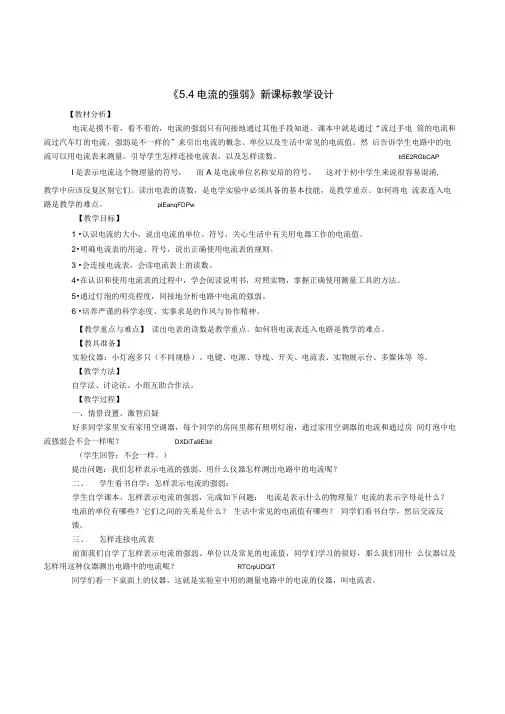
《5.4电流的强弱》新课标教学设计【教材分析】电流是摸不着,看不着的,电流的强弱只有间接地通过其他手段知道。
课本中就是通过“流过手电筒的电流和流过汽车灯的电流,强弱是不一样的”来引出电流的概念、单位以及生活中常见的电流值。
然后告诉学生电路中的电流可以用电流表来测量。
引导学生怎样连接电流表,以及怎样读数。
b5E2RGbCAP I是表示电流这个物理量的符号,而A是电流单位名称安培的符号,这对于初中学生来说很容易混淆,教学中应该反复区别它们。
读出电表的读数,是电学实验中必须具备的基本技能,是教学重点。
如何将电流表连入电路是教学的难点。
plEanqFDPw【教学目标】1 •认识电流的大小,说出电流的单位、符号,关心生活中有关用电器工作的电流值。
2•明确电流表的用途、符号,说出正确使用电流表的规则。
3 •会连接电流表,会读电流表上的读数。
4•在认识和使用电流表的过程中,学会阅读说明书,对照实物,掌握正确使用测量工具的方法。
5•通过灯泡的明亮程度,间接地分析电路中电流的强弱。
6 •培养严谨的科学态度、实事求是的作风与协作精神。
【教学重点与难点】读出电表的读数是教学重点。
如何将电流表连入电路是教学的难点。
【教具准备】实验仪器:小灯泡多只(不同规格)、电键、电源、导线、开关、电流表、实物展示台、多媒体等等。
【教学方法】自学法、讨论法、小组互助合作法。
【教学过程】一、情景设置、激智启疑好多同学家里安有家用空调器,每个同学的房间里都有照明灯泡,通过家用空调器的电流和通过房间灯泡中电流强弱会不会一样呢?DXDiTa9E3d(学生回答:不会一样。
)提出问题:我们怎样表示电流的强弱、用什么仪器怎样测出电路中的电流呢?二、学生看书自学:怎样表示电流的强弱:学生自学课本,怎样表示电流的强弱,完成如下问题:电流是表示什么的物理量?电流的表示字母是什么?电流的单位有哪些?它们之间的关系是什么?生活中常见的电流值有哪些?同学们看书自学,然后交流反馈。
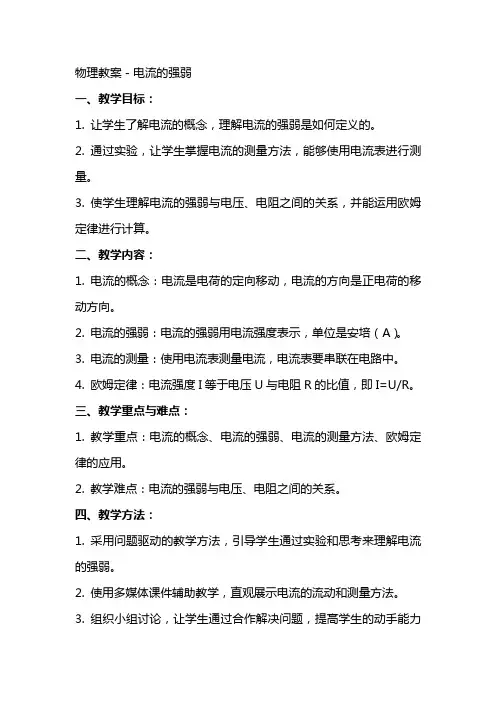
物理教案-电流的强弱一、教学目标:1. 让学生了解电流的概念,理解电流的强弱是如何定义的。
2. 通过实验,让学生掌握电流的测量方法,能够使用电流表进行测量。
3. 使学生理解电流的强弱与电压、电阻之间的关系,并能运用欧姆定律进行计算。
二、教学内容:1. 电流的概念:电流是电荷的定向移动,电流的方向是正电荷的移动方向。
2. 电流的强弱:电流的强弱用电流强度表示,单位是安培(A)。
3. 电流的测量:使用电流表测量电流,电流表要串联在电路中。
4. 欧姆定律:电流强度I等于电压U与电阻R的比值,即I=U/R。
三、教学重点与难点:1. 教学重点:电流的概念、电流的强弱、电流的测量方法、欧姆定律的应用。
2. 教学难点:电流的强弱与电压、电阻之间的关系。
四、教学方法:1. 采用问题驱动的教学方法,引导学生通过实验和思考来理解电流的强弱。
2. 使用多媒体课件辅助教学,直观展示电流的流动和测量方法。
3. 组织小组讨论,让学生通过合作解决问题,提高学生的动手能力和团队协作能力。
五、教学过程:1. 引入:通过问题引导学生思考电流的概念和电流的强弱。
2. 讲解:讲解电流的概念、电流的强弱、电流的测量方法、欧姆定律。
3. 实验:安排实验让学生亲自操作,测量电流,并观察电流与电压、电阻之间的关系。
4. 总结:通过实验结果引导学生总结电流的强弱与电压、电阻之间的关系。
5. 作业:布置相关练习题,让学生巩固所学内容。
六、教学评估:1. 课堂提问:通过提问了解学生对电流概念、电流强弱的理解程度。
2. 实验报告:评估学生在实验中的操作技能和对实验结果的分析能力。
3. 作业完成情况:检查学生对电流测量方法、欧姆定律应用的掌握情况。
七、教学拓展:1. 介绍电流的其他表示方法,如微安(μA)和毫安(mA)。
2. 探讨电流的产生原因和电流在日常生活和工业中的应用。
八、教学资源:1. 多媒体课件:展示电流的流动过程、电流表的使用方法等。
2. 实验器材:电流表、电阻、电压源等,用于演示和实验。
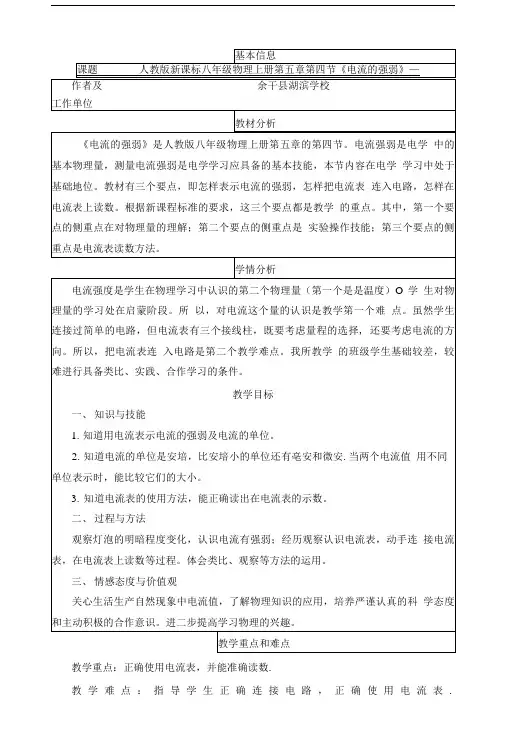
教学重点:正确使用电流表,并能准确读数.教学难点:指导学生正确连接电路,正确使用电流表.教学过程电流表的使用方法教师提出问题:电路中的电流大小用什么仪器测量?怎样连接电流表?引导学生观察电流表的外观、刻度值和接线柱,阅读课文的第二部分内容,怎样连接电流表。
教师拿出配电板(分三种配电板:第一种只有一个灯泡的电路,第二种是有两个灯泡中联的电路,第三种是有四个灯泡并联的电路)让学生依次探究,如何接入电流表测三种电路中一个灯泡的电流。
怎样在电流表上读数?教师提出问题:如何读出电流表上的示数呢?大家一起来探究。
教师展示一个电流表纸板模型,选好一个量程,拨动指针,让学生探究读数方案,读出示数。
保持指针位置不动,改变量程,读出示数。
让学生小结读数的步骤。
同学们已经懂得了电流表的连接方法和读数方法,请同学们按照己拟订的实验方案,分组进行实验。
分组实验后要求学生交流,评估和小结。
学生思考后回答。
培养联想能力。
学生观察电流表,阅读课文,思考回答问题。
学生代表上台,按照设计的探究方案演示操作过程,其余学生观看并议论操作是否正确,提出自己的意见。
学生观看后讨论回答电流表的示数,小结读数步骤。
学生连接电路进行探究实验,练习使用电流表。
使学生对电流表的构造和使用有—*定的认识,便于学生使用。
给学生提供动手、动脑、动口的时间和空间,使他们亲自参与探究、发现和体验,训练学生实验探究能力,排除故障能力,同时使学生掌握操作特点。
并逐步形成一种善于质疑、乐于探索、努力求知的心理倾向;培养良好的科学态度、探索精神和创新意识。
落实新课标要求,在强调知识的理解和记忆的同时,注重科学研究方法的学习,培养学生敢于质疑的思维习惯。
训练学生会读电流的各小组进行交流、评估和小结。
培养学生的交流、评估和小结的能力。
教学反思。
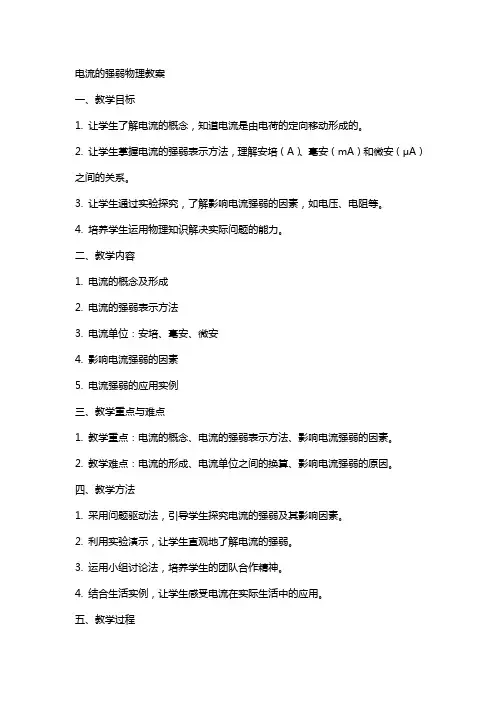
电流的强弱物理教案一、教学目标1. 让学生了解电流的概念,知道电流是由电荷的定向移动形成的。
2. 让学生掌握电流的强弱表示方法,理解安培(A)、毫安(mA)和微安(μA)之间的关系。
3. 让学生通过实验探究,了解影响电流强弱的因素,如电压、电阻等。
4. 培养学生运用物理知识解决实际问题的能力。
二、教学内容1. 电流的概念及形成2. 电流的强弱表示方法3. 电流单位:安培、毫安、微安4. 影响电流强弱的因素5. 电流强弱的应用实例三、教学重点与难点1. 教学重点:电流的概念、电流的强弱表示方法、影响电流强弱的因素。
2. 教学难点:电流的形成、电流单位之间的换算、影响电流强弱的原因。
四、教学方法1. 采用问题驱动法,引导学生探究电流的强弱及其影响因素。
2. 利用实验演示,让学生直观地了解电流的强弱。
3. 运用小组讨论法,培养学生的团队合作精神。
4. 结合生活实例,让学生感受电流在实际生活中的应用。
五、教学过程1. 导入:通过电源、电线和灯泡的图片,引导学生思考电流的形成。
2. 讲解电流的概念:电流是由电荷的定向移动形成的,可以是正电荷,也可以是负电荷,还可以是正负电荷向相反方向移动形成。
3. 介绍电流的强弱表示方法:安培(A)、毫安(mA)和微安(μA),并讲解它们之间的换算关系。
4. 实验探究:让学生通过实验,观察电流在不同电压和电阻下的强弱变化,探讨影响电流强弱的因素。
6. 生活实例:让学生举例说明电流在实际生活中的应用,如家用电器、电动玩具等。
7. 作业布置:让学生结合课堂所学,完成有关电流强弱的相关练习题。
8. 课堂小结:对本节课的内容进行简要回顾,巩固学生对电流强弱的理解。
9. 课后反思:教师对本节课的教学效果进行反思,为下一步教学做好准备。
10. 教学评价:通过对学生的课堂表现、作业完成情况和实验报告等进行评价,了解学生对电流强弱知识的掌握程度。
六、教学拓展1. 引导学生了解电流的其他表示方法,如库仑每秒(C/s)和毫安时(mAh)。
四、電流的強弱課程標準要求【教學重難點】重點:正確使用電流錶,並能準確讀數。
難點:指導學生正確連接電路,正確使用電流錶。
【教學方法】實驗、討論、觀察、點撥法【教學器材】手電筒、玩具小汽車、電池、開關、導線、小燈泡。
【教學目標】1.知識與技能●知道電流是有強弱的。
●知道電流的單位是安培,比安培小的單位還有毫安培和微安。
●會連接電流錶,會讀電流錶上的讀數。
2.過程與方法●通過燈泡的明亮程度,間接分析電路中電流的強弱。
3.情感態度與價值觀●嚴謹的科學態度與協作精神。
【教學過程】一、複習提問、引入新課[演示1] (出示電路示教板)這是一個電池、燈泡、開關、導線構成的電路,當閉合開關時,同學們看到了什麼?說明了什麼?燈泡發光了,說明電路中有了電流,你看到電流了嗎?你怎麼知道電路中有了電流?這是因為我們看到燈泡發光了。
如果用手摸燈泡,還會感覺到熱,這說明電路中通有電流時會產生各種效應,如給燈泡通電後,燈絲會發熱,熱到白熾狀態就會發光,這叫電流的熱效應,除此之外,電流還有磁效應和化學效應等。
本來電流是看不見、聞不出、聽不到的,但我們可以利用電流產生的效應來認識它、研究它。
就像是我們周圍的空氣也看不見、摸不著,只有颳風時才能感覺到它的存在。
[演示2] 上面的電路如果換成兩節電池,再做效果會怎樣呢?現在請大家仔細觀察桌上的小燈泡,看燈泡上標有什麼?這些數位和符號表示的是什麼?二、新課開始1.怎樣表示電流的強弱?燈泡上的數字一部分是它的電流值,I是電流這個物理量的符號。
0.2 A是同學們實驗時用的小燈泡的正常工作時的電流值。
電流I的單位是安培,簡稱安,符號是A。
下面我要問大家了,0.2 A表示什麼意思?0.2 A也就是說小燈泡正常工作時的電流是0.2安培。
安培是法國的科學家,他在物理、化學、數學等方面都有很深的造詣,他在電學方面的研究成果尤為突出,被後人稱為“電學中的牛頓”。
為了紀念他,物理學中用安培作為電流的單位。
《电流的强弱》教学设计_初中物理人教版部编本编辑短评《电流的强弱》教学设计_初中物理人教版部编本能成功地将知识与能力,教学过程与方法,教学重难点、技能、目标结合在一起,为学生的自主学习、探究性学习提供了有效方法。
可供教学参考。
前言下载提示:教学设计是根据课程标准的要求和教学对象的特点,将教学诸要素有序安排,确定合适的教学方案的设想和计划。
一般包括教学目标、教学重难点、教学方法、教学步骤与时间分配等环节。
Download tips:Instructional design is based on the requirements of the curriculum standards and the characteristics of the teaching objects, the orderly arrangement of teaching elements, and the determination of suitable teaching plans and plans. Generally, it includes teaching objectives, key and difficult points of teaching, teaching methods, teaching steps and time allocation.【教材分析】《电流的强弱》是人教版八年级物理上册中第五章的第四节。
电流强弱是基本的物理量。
本节内容在电学学习中处于基础地位,自己动手测量电流强弱是电学学习应具备的基本技能。
教材有三个要点,即怎样表示电流的强弱,怎样连接电流表(侧重点是实验操作技能),怎样在电流表上读数(重点是电流表读数方法)。
根据课程标准的要求这三个要点都是教学的重点,对初学者也是难点所在。
【学情分析】电流强度是学生在物理电学学习中认识的第一个物理量,学生对电的认识处在启蒙阶段。
对电流这个物理量的认识是教学第一个难点。
《电流的强与弱》教案
电流的强与弱教案
教学目标
* 了解电流的概念和电流的强弱概念
* 能够正确使用电流强度的单位进行量化
* 能够通过实验和观察判断电流的强弱
* 掌握电流强弱对电路和电器的影响
教学准备
* 教师:课件、投影仪、实验器材、示范电路图
* 学生:教材、电流表、电源、导线、灯泡、电阻器等
教学过程
导入
介绍电流的基本定义和概念,引导学生思考电流的强弱对电器使用的影响。
理论讲解
1. 解释电流强度的概念:电流强度表示单位时间内电荷通过导
体的数量。
2. 介绍电流强度的单位A(安培),并与学生一起进行单位换
算的练。
3. 说明电流强度的大小和导体截面积、导体材质以及电源电压
的关系。
实验演示与讨论
1. 展示一个简单的电路图示例,并介绍所使用的实验器材。
2. 带领学生进行电流强度实验,使用电流表测量不同电路中的
电流强度,并记录数据。
3. 引导学生讨论实验结果,分析电流强度的差异和可能的原因。
拓展活动
1. 分组讨论电流的强弱对电路和电器的影响,并总结出结论。
2. 学生自行设计一个实验,验证电流强度对电器工作的影响,
并进行演示或报告。
总结与复
回顾课堂内容,强调电流强度的重要性。
引导学生总结本节课的知识点,并进行口头复。
课堂作业
1. 完成课堂练题,巩固电流强度的单位换算。
2. 设计一个简单的实验,验证电流强度对电器的影响,并撰写实验报告。
参考资料
1. 《物理教学课程标准》
2. 电流强度相关的教材和实验手册。
第四节电流的强弱教学教案广西桂林市临桂县四塘联办初级中学李桂生【教案背景】1.教材:人教新课标八年级上册2.学科:物理3.课时:1课时4.面向学生:八年级学生课前准备:1.学生、预习本课内容,分好小组,认真做好自主学案相关知识,主动提出问题,学会主动解决知识能力;2.教师准备好实验器材,学生学案,布置学生完成相关知识的自学。
【教材分析】电流是看不见,摸不着的,电流的强弱只有间接地通过其他手段知道。
课本中就是通过“流过手电筒的电流和流过汽车前灯的电流,强弱是不一样的”来引出电流的概念、单位以及生活中常见的电流值。
然后告诉学生电路中的电流可以用电流表来测量。
引导学生怎样连接电流表,以及怎样读数。
I是表示电流这个物理量的符号,而A是电流单位名称安培的符号,这对于初中学生来说很容易混淆,教学中应该提醒学生加以区别它们。
正确使用电流表,读出电流表的读数,是电学实验中必须具备的基本技能,是教学重点。
如何将电流表连入电路是教学的难点。
【教学目标】1、知识与技能(1)、认识电流的大小,知道电流的单位、符号,关心生活中有关用电器工作的电流值。
(2)、会正确连接电流表,会读电流表上的读数。
2、过程与方法(1)、通过灯泡的明亮程度,间接地分析电路中电流的强弱。
(2)、通过学习和使用电流表的过程中,掌握正确使用测量工具的方法。
3、情感、态度与价值观 在实验过程中培养学生严谨的科学态度与协作精神。
【重点】电流表的使用规则,用电流表测电流,正确使用电流表,并能准确读数。
【难点】学会正确连接电路,正确使用电流表。
【教学用具】小灯泡多只(不同规格)、电源、导线、开关、电流表、演示电流表【教学方法】讨论法、观察法、探究法、自学法【教学过程】一、创设实验情境,引入新课教师(演示实验)这是一个由电池、灯泡、开关、导线构成的电路,当闭合开关时,同学们认真观察,引导学生思考,讲述电流的效应。
并与空气类比,讲述这是一种转换法。
二、新课教学教师提出问题,相同的灯泡在不同的电源上发光一样吗?在学生回答的基础上,引导学生用实验来探究。
第四节电流的强弱八年级物理教学设计第四节电流的强弱【课标指南】1.知识与技术:会连结电流表,会读电流表的读数.2.过程与方法:经过察看灯泡的光亮程度,间接地解析电路中电流的强弱.3.感情态度与价值观:培育谨慎的科学态度与协作精神.4.要点与难点:要点:电流的观点和单位,电流表的使用;难点:对电流的理解及公式的运用,对于电流表在使用过程中需要注意的几个问题.【典例解析】例 1:某电流表有 0~3a 和 0~0.6a 两个量程,某同学使用了大批程却误用了小量程来读数,他读得的数值为 0.2a,那么经过被测电路的电流应为a.思路导航:由条件可知表盘的大批程是小量程示数的 5 倍,依据大小量程的关系,可由一个量程的读数算出对应状况下另一量程的读数.答案: 1a学法指津:两个量程的电表的读数问题应注意抓住量程的连结和各个量程的倍数关系.练习: 1、在用电流表丈量某段电路经过的电流时,王刚同学用的是小量程结果用大批程来读数,读得的数值与其真切值相差 1.6a,则经过该段电路的电流实质应为a例 2:如图 5-4-1 所示, a、b、c、d 为电路中的四个接线点,若用电流表丈量经过小灯泡的电流,则电流表的 m、n 接线柱与电路中的各接线点的连结关系为()a.m 接 a,n 接 b b.m 接 c,n 接 dc.m 接 b,n 接 a d.m 接 d,n 接 c思路导航:电流表丈量经过小灯泡的电流要求电流一定和电灯串连,因此电流表一定接在c、d 之间.并且电流表的正、负接线柱不可以接反了,一定使电流从正接线柱流入电流表,从负接线柱流出,因此m 接 c,n 接 d .答案: b学法指津:对于电流表的使用一定掌握应当按照的规则,不然会造成不良结果.练习: 2、用一个电源、一个5-4-2 所示的四个电路.此中电流个开关、两个电流表、两个灯泡构成了如图a1 能正确丈量灯 l1 的电流的是()【实验研究】例题 :依据你对电流强弱和电流表的认识,回答以下问题:(1).电流看不见,摸不着,如何才能知道它的大小呢?人们发现,电流经过导体时会产生各样效应,我们能够依据产生的效应的大小来判断电流的大小.比如,电流经过灯泡时,灯丝会变热而发光,这是电流的热效应,同一个灯泡发光由暗变亮时,表示灯泡中的电流在渐渐变大,这类研究电流的方法在物理学上称为.(2).为了正确知道电流的大小,能够把电流表与被测用电器串连来进行丈量.请连结图 5-4-3 中的电路,使小灯泡能够发光且电流表能够测出经过灯泡的电流(预计为 0.1~ 0.3a).思路导航:( 1)用看得见的宏观现象来研究看不见的微观物理问题的方法,称为“变换法”( 2)由于经过灯泡的电流预计为小于 0.6a,因此电流表应采纳 0.1~0.6a量程.为了防止电流表的“+、”“-”接线柱接错,在连结电路时往常能够在图上注明电流方向.答案:( 1)变换法( 2)如图 5-4-4学法指津:知道物理八年级物理教学设计【知识回首】【物理趣谈】电子“奇特墙纸”活色生香你对家中几年如一日的旧墙纸厌烦了吗 ?试一试瑞典科学家研制的电子墙纸吧 ! 有了它 ,只要要按一下开关,赤橙黄绿青蓝紫、图画、文字甚至照片,随时随心跃上你的墙面。
电流的强弱物理教案一、教学目标1. 让学生了解电流的概念,知道电流的单位及符号。
2. 使学生掌握电流的测量工具——电流表的使用方法。
3. 让学生理解电流的强弱与电流表的读数之间的关系。
4. 培养学生动手实验、观察现象、分析问题的能力。
二、教学重点与难点1. 教学重点:电流的概念,电流的单位及符号,电流表的使用方法,电流的强弱与电流表读数的关系。
2. 教学难点:电流表的使用方法,电流的强弱判断。
三、教学准备1. 电流表2. 导线3. 电源4. 电阻器5. 实验台四、教学过程1. 导入新课:通过提问方式引导学生回顾电荷的定向移动形成电流,激发学生学习电流的兴趣。
2. 讲解电流的概念:电流是电荷的定向移动形成的,电流的方向规定为正电荷的定向移动方向。
3. 介绍电流的单位及符号:国际单位制中,电流的单位是安培(A),符号为I。
4. 讲解电流表的使用方法:电流表要串联在电路中,电流要从“+”接线柱流入,从“-”接线柱流出,被测电流不要超过电流表的量程。
5. 演示电流表的使用:教师演示电流表的使用方法,学生跟随教师一起操作,熟悉电流表的使用步骤。
五、课堂练习1. 学生分组进行实验,使用电流表测量不同电阻器通过的电流,记录电流表的读数。
2. 学生分析实验现象,探讨电流的强弱与电流表读数之间的关系。
3. 教师选取不同电流值,让学生判断电流的强弱,并解释判断依据。
教学反思:本节课通过讲解和实验,使学生掌握了电流的概念、电流的单位及符号、电流表的使用方法。
在课堂练习环节,学生能够运用所学知识进行实验操作,并分析电流的强弱与电流表读数之间的关系。
但在教学中,要注意引导学生正确使用电流表,避免因操作不当导致实验误差。
六、教学内容1. 电流的计算:让学生掌握电流的计算方法,包括串联电路和并联电路中电流的计算。
2. 电流的实际应用:通过实例讲解电流在实际生活中的应用,如家用电器、工业设备等。
七、教学重点与难点1. 教学重点:电流的计算方法,电流在实际应用中的例子。
第四节《电流的强弱》教案(人教版初二上)
«电流的强弱»教案
●教学目标
一、知识目标
1.明白电流是有强弱的.
2.明白电流的单位是安培,比安培小的单位还有毫安和微安.
3.明白电流表的使用方法.
4.能正确读出在电流表的示数.
二、能力目标
1.通过用电流的效应来研究电流的强弱,提高学生用间接研究咨询题的方法解决实际咨询题的能力.
2.通过连接电路的实验活动,培养学生动手操作能力.
3.通过电流表的读数,训练学生的观看能力和准确读数的技能.
三、德育目标
1.通过学生连接电路的实验活动,培养学生团结协作的精神.
2.在学生对电流表读数的过程中,培养学生严谨的科学态度.
●教学重点
正确使用电流表,并能准确读数.
●教学难点
指导学生正确连接电路,正确使用电流表.
●教学方法
实验法、讨论法、观看法、点拨法.
●教学用具
手电筒、玩具小汽车、电池、开关、导线、小灯泡、电路示教板.
●课时安排
1 课时
●教学过程
一、创设实验情境,引入新课
[师]〔出示电路示教板〕这是一个由池、灯泡、开关、导线构成的电路,当闭合开关时,同学们看到了什么?
[生]灯泡亮了.
[师]讲明了什么?
[生]电路中有了电流.
[师]你看到电流了吗?你如何明白电路中有了电流?
[生]电流倒是没看见,但灯泡发光了.
[师]对.假如用手摸灯泡,还会感受到热,这讲明电路中通有电流时会产生各种效应,如给灯泡通电后,灯丝会发热,热到白炽状态就会发光,这叫电流的热效应,除此之外,电流还有磁效应和化学效应等.本来电流是看不见、闻不出、听不到的,但我们能够利用电流产生的效应来认识它、研究它.
[生]我们周围的空气也看不见、摸不着,只有刮风时才能感受到它的存在,是不是一个道理?
[师]专门正确.你的思维比老师还快.实际上这是一种间接研究咨询题的巧妙方法.
二、新课教学
[师]请大伙儿认真观看桌上的小灯泡,看灯泡上标有什么?
[生]有数字和符号.
[师]灯泡上一部分是它的电流值.I是电流那个物理量的符号.0.2 A是同学们实验时用的小灯泡的正常工作时的电流值.电流I的单位是安培,简称安,符号是A.下面我要咨询大伙儿了,0.2 A表示什么意思?
[生]小灯泡正常工作时的电流是0.2安培.
[师]大伙儿还有什么咨询题吗?
[生]安培是如何来的?
[师]安培是法国的科学家,他在物理、化学、数学等方面都有专门深的造诣,安培在电学方面的研究成果尤为突出,被后人称为〝电学中的牛顿〞.为了纪念他,物理学中用安培作为电流的单位.期望同学们能向安培学习,刻苦钻研,勇于开拓和创新.
[生]电流还有其他单位吗?
[师]请大伙儿快速阅读课本中另外两个电流的单位,并完成以下咨询题:
[投影]
1.电流的单位还有_______和_________,符号分不是_______和__________.
2.电流单位的换算关系是:
1 A=________ mA
1 mA=_______ μA
3.把«小数据»中运算器中电源的电流值、半导体收音机电源的电流值.手电筒中的电流值分不换算为以安培为单位的电流值.
[师]同学们阅读了一些电器的电流值,什么缘故都不一样呢?
[生]讲明电流有强有弱.
[师]大伙儿看我手里有手电筒和一只玩具小汽车,当它们的灯发光时,你能判定谁的电流强,谁的电流弱?再换一辆不同的汽车呢?
[生]灯泡发光越亮,电流越强.
[实验]如何样连接电流表.
[师]现在请同学们用你桌上的灯泡、导线、电池组成电路,先用一节电池供电,再用两节电池供电,注意观看灯泡的亮度.
[生]用两节电池供电时灯泡亮一些,讲明电流大.
[师]现在每组发一个能直截了当测出电流值的电表——电流表.在刚才的电路中,再接入电流表,就能够测出灯泡的电流值.只是,大伙儿要先阅读课本,讨论一下,要注意什么原那么才算正确连接电流表.
讨论之后,总结出以下几条规那么:
规那么1:电流表必须和被测的用电器串联;
规那么2:电流必须从〝+〞接线柱流到里面去;〝-〞接线柱流出来;
规那么3:不要超过电流表的量程.学生用电流表有两种量程,电流值小时用标着〝0.6〞的接线柱和〝-〞接线柱;电流值小于0.6 A时用标着〝3〞接线柱和〝-〞接线柱.
规那么4:任何情形下都不能使电流表直截了当连到电源的两极上.
[师]把握电流表的连接后,两人一组开始把你的电流表接入电路中,要注意规那么.
〔学生实验,教师给予关心和指导〕
[阅读课本]如何样在电流表上读数
读数时,要看清两点:看清所选量程的每一大格、每一小格各表示的电流值;看清测量时表针停在哪个大格、哪个小格上.
学生读数后,教师让几个小组把测得的灯泡电流值报上来,讨论显现的咨询题:
[生甲]我们组测得的值与灯泡上标的正常值不太相符,我们讨论后认为是导线上消耗了一部分电能,因此电源的电能输送给灯泡时达不到灯泡需要的正常电流值,灯泡也就不如正常时的亮.
[生乙]我们组连接电路都正确,但读数时看到另外的量程刻度上了,因此和不的组不一样.通过认真检查后,改正了错误.
[生丙]我觉得连接电路时关键要注意电流表〝+〞接线柱是〝0.6 A〞接线柱依旧〝3 A〞接线柱,确定之后就好办了.
[生丁]我有一个咨询题,那个实验中的小灯泡上标有〝0.2 A〞因此我们选〝0.3〞接线柱,假如灯泡上不标电流值呢?
[师]通过两节的电路学习,同学们对电路不再生疏.实验时专门认真,实验后又能专门好地总结 .现在,又提出了咨询题,我专门快乐!那个咨询题能够用试触法解决,你把两根导线和电流表的两个接线柱只要一接触〔不要固定〕,就可看出电流表的表针是否超过你估量的量程.如表针正好在你估量的量程内,你只要把导线固定好读数即可,相反,不在你估量的量程内呢?
[生]换成另一量程的两个接线柱即可.
[师]对.这种试触法在以后的电学中还会用到,如用电压表测电压值等.
三、小结
本节课我们要紧学习了以下内容:
1.能够用电流来表示电流的强弱.
2.正确连接电流表:电流表与被测用电器要串联;电流要从电流表的〝+〞接线柱进,〝-〞接线柱出;不要超过电流表的量程;不要把电流表直截了当连到电源的两极上.
3.正确读出电流表的读数.
四、布置作业
P100动手动脑学物理1、2、3写在作业本上.
[动手动脑学物理参考答案]
1.此题是考查单位换算的练习,只要把握安培和毫安之间的换算关系1 A=1000 mA,就可专门快得出结果:0.25 A=250毫安〔mA)
120 mA=0.12 A
2.此题分三步:第一先让学生画出电路图,注意电流表要串联在电路中,并保持电流从表的〝+〞接线柱流入,从〝-〞接线柱流出,如以下图所示.
第二步:让学生动手连接实物图,以加强从〝电路图〞到〝实物连接〞之间的操作训练.
第三步:通过电流表读出电路值,训练学生正确读出电流表的数值.
3.电流表甲的读数是0.32 A
电流表的乙的读数是0.56 A
电流表丙的读数是1.4 A
学生读完之后,互相检查,有部分学生不够认真,读小格数时显现错误;部分学生没看清接线柱接入电路中是哪个量程,就读出了读数,那个咨询题在练习中都应让学生注意.
五、板书设计电流的强弱。